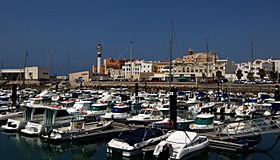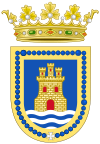Rota, Andalusia facts for kids
Quick facts for kids
Rota
|
|||
|---|---|---|---|
|
Town
|
|||

Rota port
|
|||
|
|||

Location of Rota
|
|||
| Country | |||
| Province | Cádiz | ||
| Area | |||
| • Total | 84 km2 (32 sq mi) | ||
| • Land | 84 km2 (32 sq mi) | ||
| • Water | 0.00 km2 (0 sq mi) | ||
| Population
(2018)
|
|||
| • Total | 28,848 | ||
| • Density | 343.4/km2 (889/sq mi) | ||
| Demonym(s) | Roteño | ||
| Time zone | UTC+1 (CET) | ||
| • Summer (DST) | UTC+2 (CEST) | ||
Rota is a lovely town in Spain, located in the Province of Cádiz, Andalusia. It covers an area of 84 square kilometers. Rota is surrounded by other towns like Chipiona, Sanlúcar de Barrameda, and El Puerto de Santa María.
It's also close to the city of Jerez de la Frontera and about 36 kilometers from Cadiz, the main city of the province. In 2009, about 28,516 people lived there. Rota is part of two important groups of towns: the Association of Municipalities of Cadiz Bay and the Association of Municipalities of the Lower Guadalquivir.
Rota is right on the Bay of Cádiz by the Atlantic Ocean. It's a popular spot for tourists from all over Europe, especially in the summer. When it's not tourist season, fishing is a big part of the town's economy. The Naval Station Rota, a large naval base, is also a major employer for the people of Rota. This base was even used as a backup landing site for the Space Shuttle program!
Contents
History of Rota
Ancient Beginnings
Long, long ago, in the Bronze Age, people lived where Rota is now. The town we know today was started by the Phoenicians around the same time they founded Cadiz. Some people think Rota was once called Astaroth and was part of the ancient Tartesian empire. Later, the Romans took over and called the town Speculum Rotae.
Moorish and Christian Times
When the Moors came to Spain, the city became known as Rabita Rutta. This name means "watchtower of Rota," and it's where the town gets its current name. In 1217, a group of Crusaders from Frisia, on their way to the Holy Land, raided the city.
Starting in 1248, the Moors were slowly pushed out of Spain, and Rota became a Christian town. In 1297, King Sancho IV of Castile gave the town to Alonso Pérez de Guzmán. This was a reward for his brave defense of Tarifa. Later, Pérez de Guzmán gave Rota to his daughter, Isabel, as a wedding gift.
Building the Castle
The famous Castillo de la Luna (Castle of the Moon) began construction in 1295. This was part of King Sancho IV's plan to build strong defenses along the coast. He wanted to protect the entrance to the Mediterranean Sea. During the Middle Ages, Rota was an important port for trading with North Africa. In 1780, the town was passed to the Duke of Osuna.
Economy and Jobs
Tourism and Fishing
Rota is mostly a resort town, which means it's a popular place for holidays. It has many hotels and thousands of beds for visitors. Tourists from all over Europe come here in the summer. When it's not summer, the main business is the fishing industry.
Rota is also home to the Rota naval base. This is a large base used by both the Spanish Navy and the United States Navy. It opened in 1955 and also hosts units from the U.S. Marine Corps and U.S. Air Force. It's often the first or last port for U.S. naval ships traveling to or from the Mediterranean Sea.
For a long time, the naval base was the biggest part of Rota's economy. However, since about 1995, there are fewer American personnel there. Also, better roads mean people can easily travel from nearby towns to work at the base. Because of these changes, tourism is now the main source of money for Rota.
Farming in Rota
The areas around Rota are used for farming. Farmers grow crops like cotton and sunflowers. They also grow sweet green peppers, tomatoes, and pumpkins.
Climate and Weather
Rota has a mediterranean climate with hot summers and mild winters. This type of climate is called Csa by the Köppen climate classification system. The Atlantic Ocean nearby greatly influences Rota's weather.
The average temperature in January, the coldest month, is about 11°C (52°F). In August, the hottest month, the average temperature is around 25°C (77°F). Rota gets a lot of sunshine, with over 3,000 hours of sun each year! The sea temperature is about 16°C (61°F) in winter and 23°C (73°F) in summer.
| Climate data for Rota averages. Rota Base Naval 1991-2020 normals, 1988-2021 extremes, 21 metres (69 ft) | |||||||||||||
|---|---|---|---|---|---|---|---|---|---|---|---|---|---|
| Month | Jan | Feb | Mar | Apr | May | Jun | Jul | Aug | Sep | Oct | Nov | Dec | Year |
| Record high °C (°F) | 22.6 (72.7) |
24.2 (75.6) |
30.1 (86.2) |
33.0 (91.4) |
38.0 (100.4) |
40.8 (105.4) |
42.2 (108.0) |
41.2 (106.2) |
41.0 (105.8) |
33.7 (92.7) |
27.7 (81.9) |
24.8 (76.6) |
42.2 (108.0) |
| Mean daily maximum °C (°F) | 16.2 (61.2) |
17.4 (63.3) |
19.7 (67.5) |
21.5 (70.7) |
24.6 (76.3) |
27.8 (82.0) |
30.4 (86.7) |
30.7 (87.3) |
28.0 (82.4) |
24.7 (76.5) |
19.9 (67.8) |
17.0 (62.6) |
23.2 (73.7) |
| Daily mean °C (°F) | 11.4 (52.5) |
12.4 (54.3) |
14.7 (58.5) |
16.5 (61.7) |
19.5 (67.1) |
22.7 (72.9) |
24.9 (76.8) |
25.3 (77.5) |
22.9 (73.2) |
19.7 (67.5) |
15.1 (59.2) |
12.5 (54.5) |
18.1 (64.6) |
| Mean daily minimum °C (°F) | 6.5 (43.7) |
7.3 (45.1) |
9.6 (49.3) |
11.5 (52.7) |
14.3 (57.7) |
17.5 (63.5) |
19.4 (66.9) |
19.8 (67.6) |
17.8 (64.0) |
14.7 (58.5) |
10.3 (50.5) |
7.8 (46.0) |
13.0 (55.5) |
| Record low °C (°F) | −4.7 (23.5) |
−2.3 (27.9) |
0.4 (32.7) |
3.6 (38.5) |
6.8 (44.2) |
10.8 (51.4) |
11.5 (52.7) |
13.3 (55.9) |
10.3 (50.5) |
6.2 (43.2) |
0.0 (32.0) |
−1.6 (29.1) |
−4.7 (23.5) |
| Average precipitation mm (inches) | 66.9 (2.63) |
51.4 (2.02) |
57.5 (2.26) |
45.6 (1.80) |
31.3 (1.23) |
4.7 (0.19) |
0.5 (0.02) |
2.0 (0.08) |
26.0 (1.02) |
80.6 (3.17) |
87.5 (3.44) |
81.1 (3.19) |
535.1 (21.05) |
| Source: AEMET OpenData / AEMET | |||||||||||||
Population of Rota
| Historical population | ||
|---|---|---|
| Year | Pop. | ±% |
| 1999 | 25,198 | — |
| 2000 | 25,560 | +1.4% |
| 2001 | 25,919 | +1.4% |
| 2002 | 26,257 | +1.3% |
| 2003 | 26,431 | +0.7% |
| 2004 | 26,691 | +1.0% |
| 2005 | 26,792 | +0.4% |
| 2014 | 29,179 | +8.9% |
| Source: INE (Spain) | ||
The table above shows how Rota's population has grown over the years. This information helps us understand how many people live in the town at different times.
Delicious Food and Drink
Rota has some special traditional dishes. One famous dish is arranque. It's made with chopped bread, tomatoes, green peppers, garlic, salt, and olive oil. It sounds simple but it's very tasty!
The local wine is called tintilla. It's made from dark, ripe grapes. You can find it in the many bodegas (wine cellars) around the old town. One famous bodega is El Gato, which makes its own wine.
You can also enjoy many other Spanish and Andalusian foods in Rota. Some popular dishes include caracoles (snails), menudo (a type of tripe soup), and chicharrón (deep-fried pork rinds). And of course, there's gazpacho, a cold tomato soup that many people drink, especially in the summer.
Arts and Culture
The Ruiz Mateos Foundation gives out an award called Villa de Rota every two years. This award celebrates achievements in plastic arts (like painting and sculpture), music, and literature.
The works that win awards, along with other donations, are displayed in the Ruiz Mateos Museum. This museum opened in 2005 and has over 100 pieces of art. It includes oil paintings, watercolors, engravings, and sculptures. Many talented artists, like Antonio Utrera, Francisco Luque, and Dominika Grisgrabed, have won the contest.
Sports Teams
Rota is home to two football (soccer) teams: CD Rota and UD Roteña. If you like basketball, Rota also has a team called C.D. Don Bosco 88.
Images for kids
See also
 In Spanish: Rota para niños
In Spanish: Rota para niños













